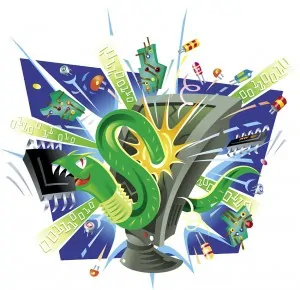Last modified 01/24/2024
Most destructive PC viruses of all time,what damage can a computer virus do to a computer:
Almost everyone who has had a computer in his or her home or work, has been a victim of some sort of virus or informatics worm, this is mainly because our operative system, mostly Windows, is very vulnerable to viruses in comparison with other operative systems such as: Mac OS or Linux. This is why many people switch to these operative systems that are much less vulnerable to attacks due to the fact that most programmers develop them for Windows. Anyhow, Windows will always be the most outstanding one, due to its popularity.
According to this list, the most damaging viruses and worms have been:
The worm: ILOVEYOU, this type of worm was developed with the aid of the Visual Basic Script Program and it spreads through e – mails and IRC) Chat from web pages). It has been the most spread virus in history and it has affected both, people and huge companies.
The way in which it reaches is through an e – mail with a message that looks like “ILOVEYOU” and an enclosed file with the name LOVE-LETTER-FOR-YOU.TXT.vbs, as you can see in the .vbs extension, it belongs to a Visual Basil file, but with the Windows’ settings, it can appear to look like a text document (.txt). When the file is downloaded it executes itself in our computers and auto spreads by sending itself to all our Outlook contacts. This virus damages our documents by changing their names and sizes; it also changes our explorer’s home page.
The virus: Mydoom: is a variant of MIMAIL and it is massively spread through e – mails and P2P nets, such as Emule, Kazaa, Ares, etc. Usually, it is sent with an easily detectable name or text. It also uses the name of some harmless file to be able to enclose the executable file; it usually deactivates the firewall, which makes it possible for the computer to be executed from some remote place.
The worm: Blaster, this work spreads itself pretty easily because it is specialized only in Windows NT, 2000, XP and 2003. It uses a common weakness in these operative systems, known as “buffer overflow in RPC DCOM”.
It affects the Windows Update and the web navigator; it can also provoke some instability in the system, as well as exhaust the memory with unused files. From June of 2003, there is a patch to solve this problem, because it used to spread through the usage of the TCP 135 Bridge, which is avoidable by activating our system’s firewall.
The worm: Sobig Worm, created in Visual C++. This worm is specialized in Windows XP, 2000, NT, ME, 98, 95, it is spread through e – mails, and it looks for all the extensions such as .txt, .eml, .hml, .dbx, and .wab. The e – mail that we usually get it from is big@boss.com. It is typically replicated by making copies of itself in computers that are connected via LAN or through remote connections. It opens up the ports 995 to 999; it remains waiting until it receives orders and it also possesses the ability to download files or other type of files from the internet.
